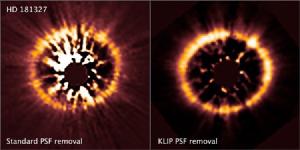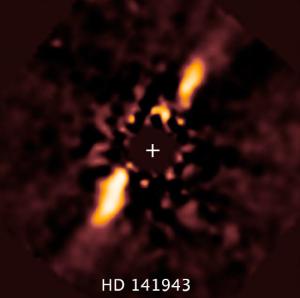Blog
Second Look
28 April 2014
 NASA/ESA/R. Soummer, Ann Feild, STScI
NASA/ESA/R. Soummer, Ann Feild, STScIOne of the advantages of modern astronomy is that most observational data gets stored in a raw form. This is particularly true for the major space telescopes. Most of that raw data is also stored publicly, either a certain time period or even as the data is gathered. This means that long after an observation is made, people can go through the data to analyze it in new ways. As a case in point, a team recently gathered old data from the Hubble Space Telescope, and processed it using new methods. From these they discovered debris disks around five stars.
The data on these stars was originally gathered between 1999 and 2006. Earlier, infrared observations of these stars by the IRAS and Spitzer telescopes showed them to have an unusual signature that could indicate a debris disk around the stars. So detailed observations of the stars were made with Hubble’s Near Infrared Camera and Multi-Object Spectrometer (NICMOS), but there was no clear debris disks to be seen. Part of the challenge with this kind of observation is that you want to observe infrared light scattering off the debris disk. That disk is orbiting a star which is much brighter in infrared, so you need to block the star while still taking sensitive measurements. The resulting data can be pretty noisy, which makes it hard to distinguish data from noise.
 NASA/ESA/R. Soummer, Ann Feild, STScI
NASA/ESA/R. Soummer, Ann Feild, STScIBut over the past decade computers have gotten more powerful and the methods of extracting signal from noise have gotten better. So this team went back to the original data and re-analyzed it. Their results were published in the Astrophysical Journal Letters this month.1 The results clearly show scattered light debris disks around these stars. This actually increased the number of known scattered light disks by almost a factor of 3. The team was also able to determine the size and orientations of these disks, which is pretty impressive.
One of the stars, with the memorable name HD 141943, is very similar to the early Sun. It’s debris disk is asymmetrical, which suggests that there are proto-planets gravitationally influencing it. One of the things the team plans for future research is to further process the data to resolve these proto-planets. If they are successful it could lead to new insights on how exoplanetary systems form.
What is particularly cool about this research is that it used publicly available data. You can actually go to the Mikulski Archive for Space Telescopes and access this kind of data yourselves, at no cost to you. If you use the data in a research project, all you need to provide is an acknowledgement in your paper. There is a wealth of data there, and all it needs is a second look.
Soummer, Rémi, et al. “Five debris disks newly revealed in scattered light from the Hubble space telescope NICMOS archive.” The Astrophysical Journal Letters 786.2 (2014): L23. ↩︎